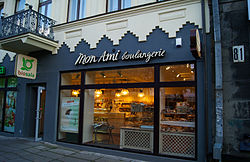Finance:Storefront

A storefront or shopfront is the facade or entryway of a retail store located on the ground floor or street level of a commercial building, typically including one or more display windows. A storefront and 3.
functions to attract visual attention to a business and its merchandise.[1]
History

Before the middle of the 19th century, shop fronts did not have large display windows, but often included features such as awnings and bay windows to attract the attention of passersby.[citation needed] Modern storefronts with display windows developed at mid-century after architectural cast iron became widely available and glass manufacturers began producing large panes of glass at relatively low cost.[2]
In the United States, storefronts with large windows become available after 1883, when the Pittsburgh Plate Glass company started to produce plate glass.[3] Also architects started to experiment with iron columns and lintels at the ground floor level.The combination of these two achievements led to the storefront as we know it today.[2] By the 1920s, storefront plans with deep display windows, known as the “arcaded” front, had become popular.[4]
Storefront designs
The storefronts of commercial buildings are often substantially altered even when other architectural elements remain intact. Such alterations can adversely affect a historic building's architectural and historic character.[2] Storefronts can also have an area in front of the unit called a "pop-out zone", which is about 500-1000 mm deep.[5] Storefronts often use channel letters.[6]
Other uses
E-commerce websites are sometimes called "online storefronts" or "virtual storefronts".[7][8]
See also
- Brick and mortar
- Boutique
- Digital economy
- Digital currency
- Online shopping
- shopping cart
- Storefront church
- Storefront school
References
- ↑ "Sign and Facade Guidelines". City of Somerville, Massachusetts. 2008. http://www.somervillema.gov/sites/default/files/documents/SignAndFacadeGuidelines.pdf.
- ↑ 2.0 2.1 2.2 Jandl, H. Ward (1982). "Rehabilitating Historic Storefronts". National Park Service. https://www.nps.gov/tps/how-to-preserve/briefs/11-storefronts.htm.
- ↑ Bock, Gordon (1988). "Glass Notes". The Old-House Journal (August): 38. https://books.google.com/books?id=l01IUIQ7hNUC&pg=PA38. Retrieved August 1, 2021.
- ↑ Jackson, Mike (2014). "Main Street meets Mid-Century Design". MainStreetNow (Summer): 10. https://dahp.wa.gov/sites/default/files/MainStreetNow_Summer_2014.pdf. Retrieved August 7, 2021.
- ↑ Mesher, Lynne (2017). Basics Interior Design 01: Retail Design. Bloomsbury Publishing. p. 147. ISBN 9781350034495. https://books.google.com/books?id=x-g4DwAAQBAJ&pg=PT147.
- ↑ Davies, Helen (April 20, 2021). "Full Look Into Your Storefront Sign Cost: 6 Main Points". https://www.frontsigns.com/blog/full-look-into-your-storefront-sign-cost-main-points/.
- ↑ Lynch, C.G. (May 18, 2008). "Most Virtual Storefronts Fail". PC World. http://www.pcworld.com/article/146032/article.html.
- ↑ Raymond, Scott (March 2, 2011). "Virtual storefronts vs. brick-and-mortar". ZDnet. http://www.zdnet.com/blog/perlow/virtual-storefronts-vs-brick-and-mortar/16044.
 |


